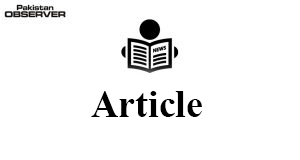Dr Sami Ullah
PAKISTAN is ranked on top position in the world regarding charity for poor and vulnerable groups in the society. This taste of philanthropy has been observed on every occasion of crises throughout the history of Pakistan. Our role is exemplary in the situation of floods, earthquake, COVID-19, droughts or terrorism and people have contributed more than their capacity. The statistics of 2020 shows that Pakistani people have served the needy equal to 1.4 percent of GDP, whereas UK and Canada are behind Pakistan with 1.3 and 1.2 percent of GDP spending for charity. This is the best thing for Pakistan that we are underdeveloped in all the aspects, on the other hand, we are best for the support of our vulnerable parts of the society. There is also a significant amount spent every year through BISP, Ehsaas, Zakat/Baitul Mal and other poverty alleviation programs of the state. Almost all the programs are with more than Rs 100 billion worth for each.
After the expense of this huge support from individuals and state, there are still 70 million people with food insecurity and go hungry on bed every day. We have the highest number of “out of school children” and currently 25 million kids are unable to attend school in their school going age. Almost half of the population is unable to earn even US$ 2 a day and living below the poverty line. Half of the kids are unhealthy and lacking in basic health and nutrition facilities. On the basis of these empirics, a common man can ask the question, why huge amount of financial support from individuals and state is not empowering the poor families. Is the direction of support not in line with sustainability and empowerment? There is dire need to explore the missing dimensions of this under-development.
In the science of economics, when we measure the well-being of the people, there are two approaches based on income and consumption as the indicators of welfare. After telling long story in short, consumption level of the families is considered as the best welfare indicator because increased income is not the conformity that it is contributing in the well-being of the family. If someone is helping the needy people in cash, there is no guarantee that this increased income will enhance the consumption or welfare level of the family. But, if support is in the shape of consumption basket then there is more probability that their welfare is enhanced because they have to consume in either case. Same is the case of state, in almost all the state welfare projects, they are helping the poor in cash and this approach is not putting sustainability or enhancing the skill level and capacity building of the masses. On the other hand, if families are supported in the form of skill development, education of the kids, entrepreneurial development and women empowerment, instead of cash support, you will feel the sustainability of the families in a very short time. Even the amount of charity given by individuals can be replaced from cash to capacity building which is not only supporting family financially but also sustaining them for the long time.
Even in the times of COVID-19 crisis, many of the severe cases were found in developed countries regarding their basic needs fulfillment because they have very poor societal and family structure. They have achieved economic prosperity on the cost of societal development. On the other hand, Pakistani organizations, societies and group of individuals have worked hard for the provision of basic needs for the economically vulnerable families by ensuring that no one go hungry on bed during the tough time. This is the beauty of our society and we can easily track on it for the empowerment of our deprived groups.
This is the appropriate time to motivate state and individuals regarding the poverty alleviation and well-being programs. If we change the trend from income support to consumption support, this will be the source of long run prosperity of the families. It is also worthwhile to mention that this well-being will also contribute in the GDP growth of the country. Our media and civil society can educate the philanthropist to spend on the education, health, skill development and employment generation of the deserving families for their sustainability. Charity can be inclusive if the focus is on consumption oriented activities, instead of just income support. Through this huge amount of charity and poverty alleviation programs, state can develop some institutions for the capacity building and skill development of the poor families. If state introduces some inclusive policies, there will be a significant increase in the employment generation, welfare of the vulnerable along with economic sustainability of the country.
—The writer is Assistant Professor in Economics, University of Gujrat, Pakistan.










